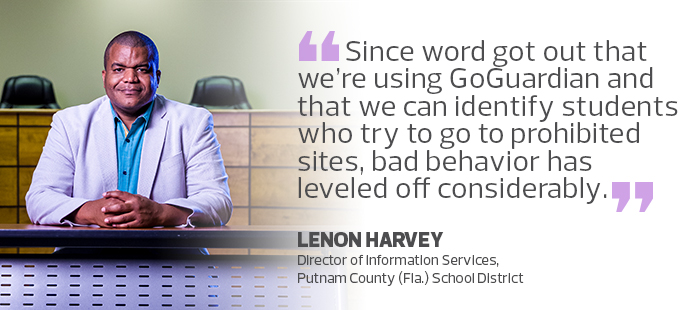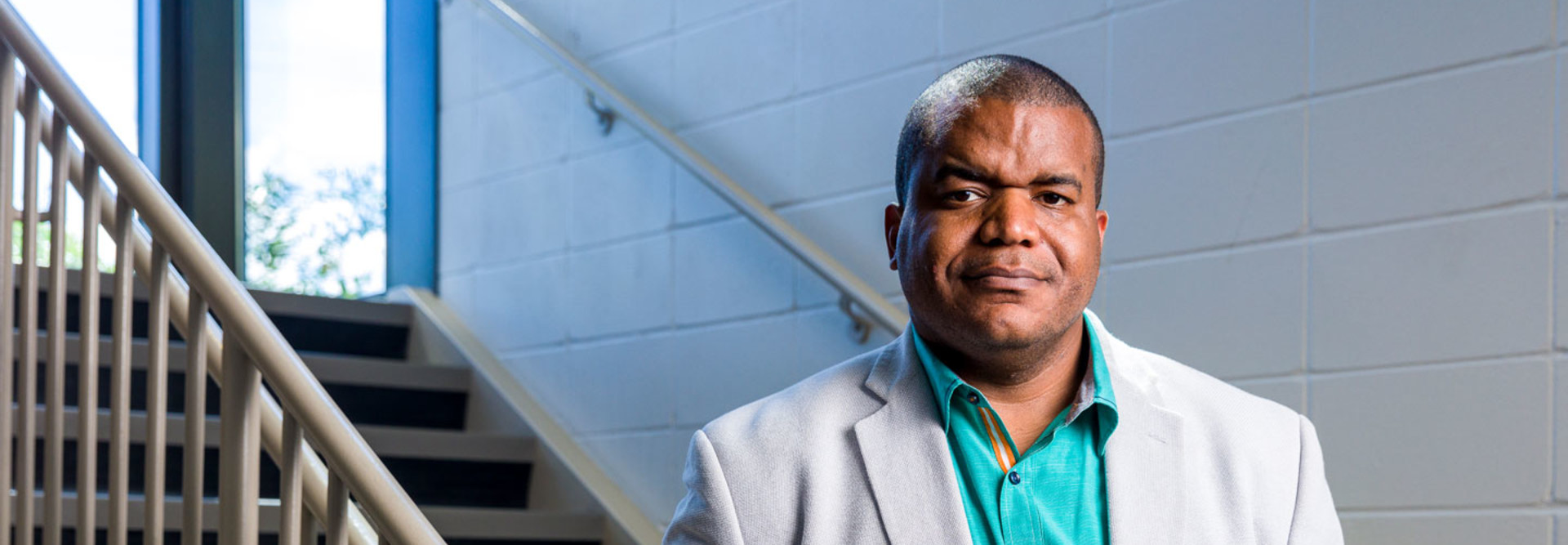In education, software programs lend a helping hand just about everywhere, from device management to digital learning. Some schools even rely on software to save lives.
Soon after Putnam County School District adopted GoGuardian internet content monitoring, it detected four troubled students making Google searches that were variations on the query “how to kill yourself.” The GoGuardian software immediately generated urgent alerts to multiple administrative staff members, as did SysCloud, the Florida district’s second layer of content monitoring.
“Reports went to an assistant principal or dean at each school, on to the child’s counselor, and then the parents were contacted, all very rapidly,” says Lenon Harvey, PCSD’s director of information services. “We learned that one child had planned to commit suicide in the next couple of days — because of the monitoring, we were able to intervene and get him the services he needed.”
The technology proves its worth day to day by blocking prohibited sites and flagging online searches for inappropriate content, such as pornography, drug use or other violations of the district’s acceptable-use policy, says Harvey. It also acts as a deterrent to students who might be tempted to go searching for trouble on the internet.
“Since word got out that we’re using GoGuardian and that we can identify students who try to go to prohibited sites, bad behavior has leveled off considerably,” Harvey says.
MORE FROM EDTECH: Read more about how web filters keep students safe!
Alerts Help Schools Protect Students and Data
The district is more interested in protecting students and their data than punishing violators of the acceptable-use policy, Harvey says. PCSD deploys Cisco Meraki MX 600, a cloud-based security appliance that provides content and web-search filtering, along with next-generation firewalls and intrusion detection. Last January, PCSD installed GoGuardian Admin on its Chromebooks, which the district provides for 11,600 students in its 18 schools.
GoGuardian Admin offers adjustable, policy-based filtering that blocks prohibited sites and alerts administrators when students attempt to access inappropriate content, even on a permitted site. The district also uses GoGuardian Teacher for classroom management.
Information Services Project Manager Justin Lehtinen cautions that content monitoring can result in a flood of alerts, and that districts need clear protocols to deal with them.
“It’s easy to be overwhelmed, and you need ways to quickly evaluate the flag’s urgency,” he says. “The technology does some prioritizing, but you respond to all of them. Some incidents are harmless, but with others, the staff has to react right away to see what’s going on with the individual.”
Use Common Sense to Guide Tech-Enabled Monitoring
A very high percentage of K–12 districts deploy internet content monitoring because “it’s the right thing to do” for student safety, but also because they will be ineligible for federal E-Rate technology discounts if they don’t, says CoSN Board Secretary Donna Williamson, who is also chairwoman of CoSN Alabama Leaders, founding member of the Alabama Education Technology Association and technology director of Mountain Brook Schools in suburban Birmingham.
“There’s no question that a district should monitor online activity, but the technology raises other questions,” says Williamson. “How do you determine what you filter and flag? At what age? What do you filter if the devices go home? What responsibility do you have to report students’ online behavior to parents? There’s a lot to think about.”

Knowledge of both the school and wider communities is crucial to setting effective policies and enforcing them with filtering and monitoring, and transparency with students and parents is also key, Williamson says.
“You always want to maintain a level of trust,” she says. “It’s very important to keep students safe, but it’s also important to use common sense. Some alerts from the technologies require administrators to react at once. But a lot of them are minor, the result of students not using good judgement, of being kids. In those cases, it’s important not to overreact.”
MORE FROM EDTECH: Check out how schools are getting parents involved towards a successful 1:1 device program!
Automated Filters Offer K–12 Schools Long-Distance Protection
Before it adopted Lightspeed Systems’ Relay device filter in January, Nye County School District had no way to monitor internet content on its 4,500 ASUS and Acer Chromebooks, which were distributed to students in schools spread across the 18,182-square-mile district in western Nevada.
“It’s a seven-hour drive from my office to our farthest school, and we have a staff of five — we really needed an automated solution, if we were going to keep students safe and know they were following our terms of use,” says Robert Williams, technology director at NCSD, which enrolls about 6,000 students in 18 schools.
Lightspeed Relay blocks prohibited websites and alerts IT and appropriate school staff if a student tries to reach a questionable site, says Williams. The content filtering can be adjusted according to grade level or other factors.
When a student’s internet activity is flagged, an administrator or counselor meets with the student, and the behavior is rarely repeated, says Williams. Most offenses are relatively minor violations of the district’s use policy — although a few enterprising students were caught looking for instructions to install a VPN for bypassing the web filter.
In April, NCPS added a Relay feature that monitors students’ district email accounts for key words and phrases that might indicate an interest in pornography, drugs, self-harm, suicide, gun use, or use policy violations. “We’ve had at least two cases where we’ve identified students who were thinking about suicide, and we were able to notify administrators and get them appropriate help,” says Williams. “Ninety-nine percent of what is flagged is pretty innocuous, but we want to make sure we catch the small amount that’s not.”
MORE FROM EDTECH: Read ISTE's 5 best practices for adhering to federal student privacy laws!
Machine Learning Can Identify Students Who Need Help
Like PCSD, California’s Redding School District uses GoGuardian as a key component in its content monitoring strategy to protect students from the darker side of the web, and also to help teachers manage their classrooms, says RSD Superintendent Robert Adams. Located near the Oregon border, the district has eight schools, plus several partner schools and a home schooling program.
RSD adopted content monitoring four years ago while planning for its one-to-one program, which involves about 2,500 of the district’s 2,900 students, beginning in the second grade. By fourth grade, students are allowed to take their devices — either a Samsung Chromebook 2 or a Dell Chromebook 11 — home.
“We want to protect them from inappropriate content and keep the trust of parents, who expect us to create a safe environment for students,” Adams says.
In addition to blocking sites designated off-limits by RSD, GoGuardian Admin uses machine learning algorithms to provide contextual awareness as the software continuously scans content — blocking dangerous content or sending cautionary messages to students and alerts to administrators.
Admin offers granular filtering that can be adjusted for on- or off-campus use of devices, and settings can be customized for individual students. GoGuardian also tracks the Chromebooks to facilitate recovery of lost or stolen hardware. RSD uses GoGuardian in conjunction with Gaggle, which combines machine learning technologies and trained human observers to monitor email messages and documents created or shared by students.
The district recently adopted GoGuardian Teacher, which allows teachers to view their students’ screens in the classroom to see what sites and documents students have open. Using GoGuardian, teachers can message students in real time to assist them and keep them on task.
While content monitoring enforces good digital citizenship, the technology is more than a disciplinary tool, Adams says. “The biggest benefit is that we can use the technologies to identify students who are distressed or need services,” he says. “We might have identified them through our counseling program, but the content monitoring is an important tool for communicating student needs.”









